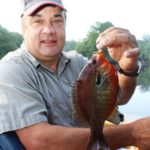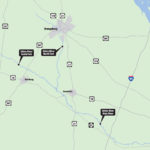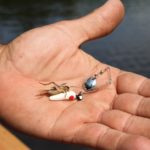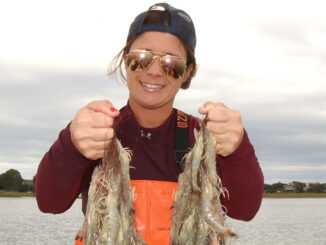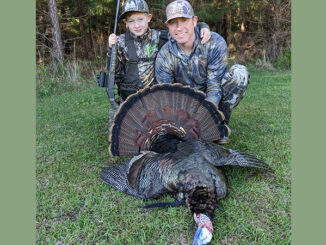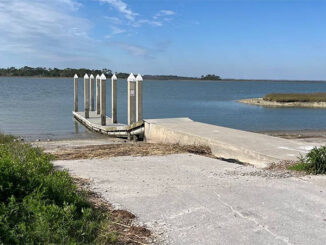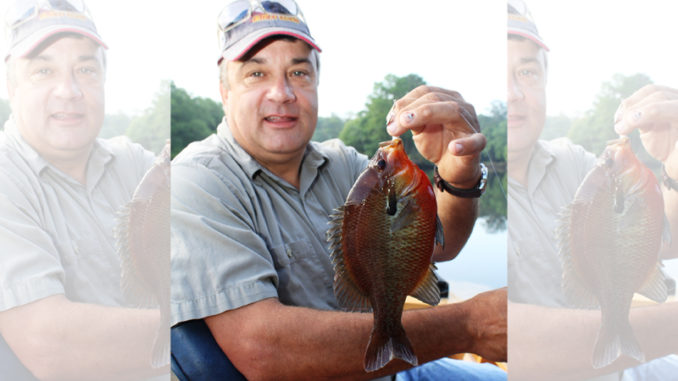
A small vessel and some basic tackle can put you in touch with a stringer full of Edisto redbellies
Ask Ridgeville’s Billy Garner about the best month to fish the Edisto River, and he’ll tell you any month with a weekend. But he likes fishing in July because the weather is hot, meaning fewer people are on the river.
“Late April to mid-May, a lot of people fish here because the redbreast are biting well and the weather isn’t too hot. By July, the hot weather counts out many of the fair-weather fishermen,” said Garner. He said no matter how high the temperature soars, the fish still bite. The key, he said, is focusing on shaded areas.
The “E” in ACE Basin, the Edisto is the longest, free-flowing blackwater river in North America — more than 250 miles from its headwaters in Edgefield and Saluda counties to the saltwater of Edisto Beach. It actually forms as two separated forks — the North Fork and South Fork, and meets to form the main stem of the Edisto River. Then it splits again, this time into the saltwater North Edisto and South Edisto rivers. The sheer length of the river hints at the diversity of fish that call it home.
The S.C. Department of Natural Resources has documented more than 87 freshwater species in the Edisto. But the main focus for most anglers is the handful of bream species, especially the brightly-colored redbreast sunfish.
Anglers know this river as redbreast waters
“The redbreast is definitely the signature fish of the Edisto River,” Garner said. “It’s just not a fish you can find in all bodies of water.”
Chris Thomason, an SCDNR fisheries biologist, said that while redbreast can survive in lakes and impoundments, they prefer the moving water most-often associated with rivers and streams. They also reproduce more rapidly. And their young survive more readily in habitat that features a combination of moving water, submerged structure and a constant influx of food like insects, small crustaceans and small fish. The Edisto has all that, and an abundance of redbreast to go along with it.
The North and South forks are similar to the main stem when it comes to species and methods of catching them. But there is a big difference in accessibility. While numerous boat landings dot both of the upper forks, most are suitable for canoes and small johnboats only. And the number of downed trees blocking the river changes weekly.
The main stem of the Edisto River — where the two forks meet in Bamberg County, is wider. This means improved boat landings that can handle a variety of boat sizes. It’s not uncommon to see professional-grade bass boats on this section. And for obvious reasons, this part gets more attention from freshwater anglers.
Other panfish are also common
Garner has fished this main stem in everything from a wood-strip sneak boat powered by an electric motor to a 20-foot bass boat. And while the biggest draw is redbreast, other panfish species also bite readily throughout the summer.
Garner said anglers can catch redbreast, bluegill and pumpkinseed throughout the day, even on the hottest days.
“As long as you keep your lures or bait in those shaded areas, you’ll catch fish all day long,” he said.
And there is plenty of shade all along the Edisto. Cypress trees and willows line much of the banks, providing shadows where all sunfish species love to hide out.
Garner said all the bream hang out all along the banks. It just takes trial and error to find them each time out.
“I like to focus on the darker water under the cypress trees and in the sharp bends of the river where the water is generally deeper,” he said. “The willow trees mainly grow on white, sandy banks. Those banks are usually more shallow (and) have little underwater structure. I pay less attention to those, but I don’t ignore them altogether. Sometimes, the bream will be on those banks for whatever reason.”
Don’t overlook wooden seawalls
He said on some days, anglers catch a variety of bream all from the same spots, but that usually, one species dominates the bite in a given area.
“When I’m catching redbreast on lures in the middle of the water column, I can catch bluegill on the bottom with live bait, but some days, it’s the bluegill in the middle and the redbreast on the bottom,” he said.
Aside from tree-lined banks, Garner said seawalls are also great spots to target. The bream find these man-made wooden walls attractive for a number of reasons. And they give anglers an easy target to shoot for without the hazards that come with fishing around trees and low-hanging branches.
Garner said using a bow-mounted, foot-controlled trolling motor is the best way to pursue these fish on the Edisto.
“I like to keep the front of the boat pointed into the current,” he said. “Even if I want to go downriver, I’d rather have the front pointed upriver, then just drift backwards. I’ll use the trolling motor to steer the boat.”
With a background in bass fishing, Garner much prefers artificial lures. And he said the bream don’t mind that at all. Small, ultralight spinning outfits spooled with 6-pound line and tipped with small spinners are invaluable for this task. Garner carries a tackle box full of Johnson Beetle Spins on every fishing trip.
Try different colors
“Beetle Spins are really all you need for catching any of the bream species, and they’ll bite different colors throughout the day. So it’s best to try different colors until you start catching them good on a certain color, then stick with that until the bite slows,” he said. White-bodied spinners with a red dot are often his go-to lure.
Another trick that Garner and other locals use once the bite gets tough is to add a live cricket to the Beetle Spin’s hook, then fish the lure in a normal manner.
“Sometimes, casting a plain Beetle Spin simply won’t work when the bream get finicky, but you’ll catch them with a cricket attached,” said Garner. “I think the size and movement of the Beetle Spin initially attracts them. And the cricket seals the deal when they aren’t feeding aggressively.”
“By this time of year, the bluegills are usually more active than the redbreasts, but redbreast will still bite Beetle Spins early in the morning and late in the evening. Bluegills seem to bite throughout the day like bass,” he said.
Live bait works well during mid-day
When the bream stop biting artificials, Garner said it’s time to soak bait on the bottom. This will catch both bluegills and redbreasts.
“The best bait by far,” said Garner, “is what we call a blue bait.” A locally found worm that lives along the banks of the Edisto, blue baits are generally not found in bait stores.
“Every so often, you’ll find a tackle shop with some, or you’ll hear of a local that has some for sale. But usually you have to dig them up yourself. Just put one on a bream hook with enough weight to get it to the bottom, cast around cypress trees and in the deep, outer bends of the river, and let it sit on the bottom,” Garner said.
Nightcrawlers, red wigglers and crickets fished on the bottom will also catch bream. But Garner said the blue baits outfish all of them combined. And while bluegill and redbreast are the most populous bream, other sunfish like pumpkinseed, warmouth, shellcracker, and fliers will also bite the same lures and baits.
DESTINATION INFORMATION
HOW TO GET THERE — The North Fork of the Edisto River is most easily accessible by US 178, SC 3 and US 21. The South Fork has easy access from US 78, US 321 and SC 322. SC 61, US 17 and US 78 offer easy access to the main stem of Edisto River. Prime landings on the North Fork are Pooles Mill on SC 3 and Jones Bridge on SC 394, on the South Fork, Hog Pen off SC 3 and Ness Bridge at US 70, and main stem, Zig Zag at SR 34 and Jellicos at US 17A.
TACKLE/TECHNIQUES — Ultralight or light-action spinning tackle is perfect for casting spinners, including Beetle Spins, Roostertails and Mepps, around sea walls, downed trees and shady riverbanks. Live baits fished on the bottom will also catch panfish: crickets, blue baits, nightcrawlers and red wigglers.
FISHING INFO/GUIDES — Edisto River Adventures, Ridgeville, 843-870-6978; Black Water Bait and Tackle, Ridgeville, 843-873-4002; Hwy 17A & 61 Tackle Shop, 843-851-3341.
ACCOMMODATIONS — Villa Motor Inn, Williston, 803-266-7001; Inn of Denmark, Denmark, 803-793-6300; Aiken State Park, Windsor, 803-649-2857; Leesville Lodge, Leesville, 803-632-1082; Econo Lodge Inn & Suites, Orangeburg, 800-230-4134; Days Inn, Ladson, 843-797-1214; Givhans Ferry State Park, 7, Ridgeville, 843-873-0692.
MAPS — Navionics, 800-848-5896, www.navionics.com; DeLorme’s South Carolina Atlas and Gazetteer, 800-561-5105, www.delorme.com; Kingfisher Maps, 800-326-0257.
Click here for some interesting facts about redbreast bream.

